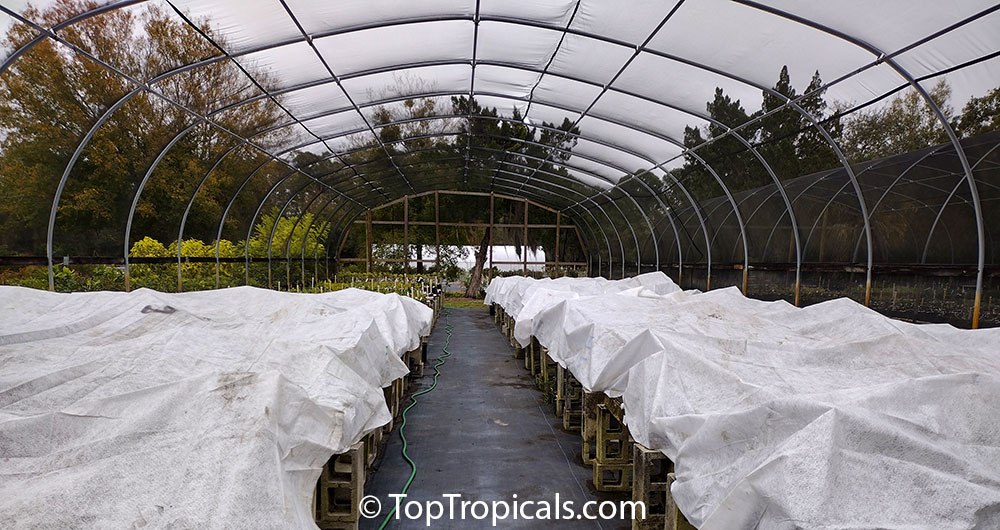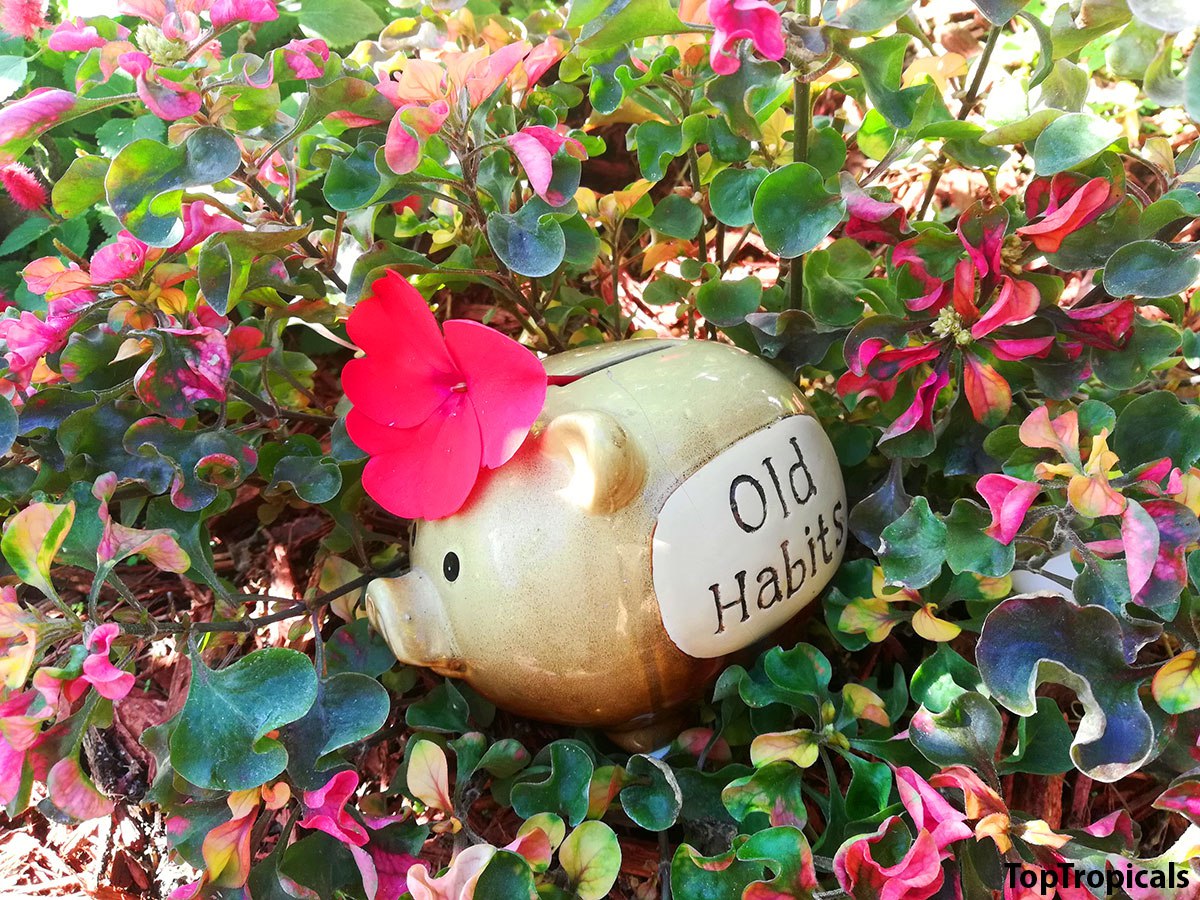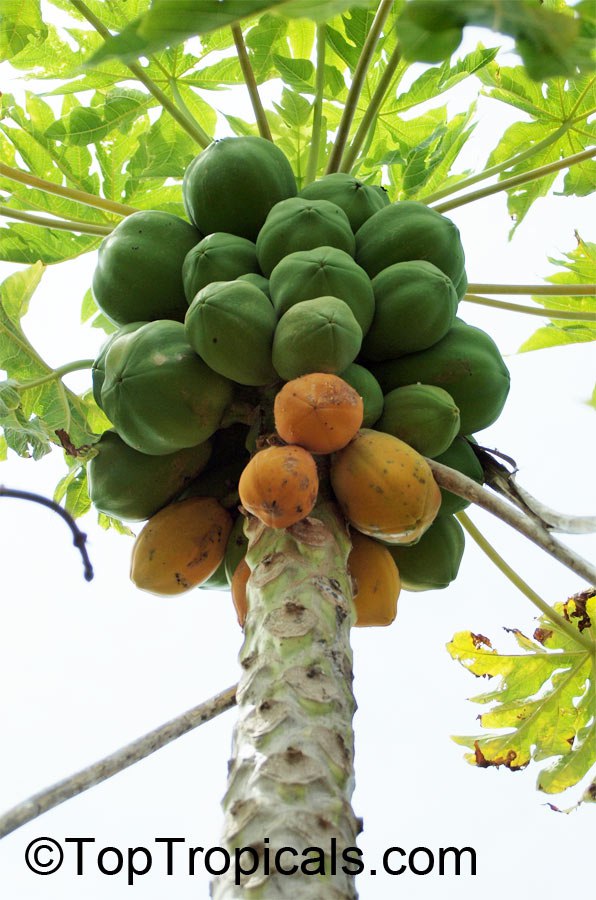Garden Blog - Top Tropicals
How to grow Mandevilla: Practical Guide to Growing Mandevilla Vine
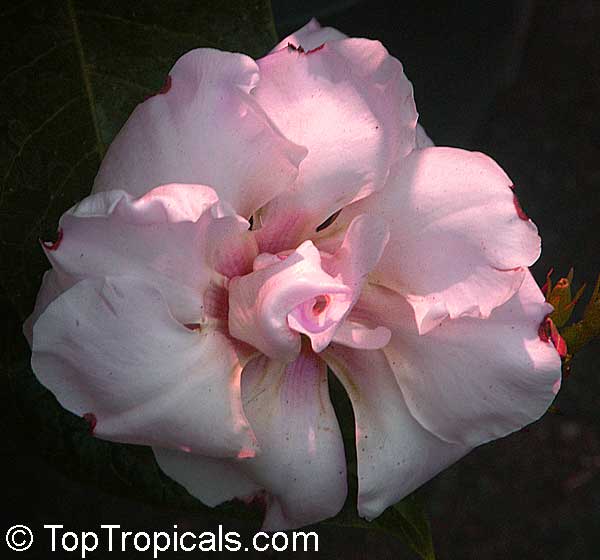
Mandevilla amabilis Thai Rose
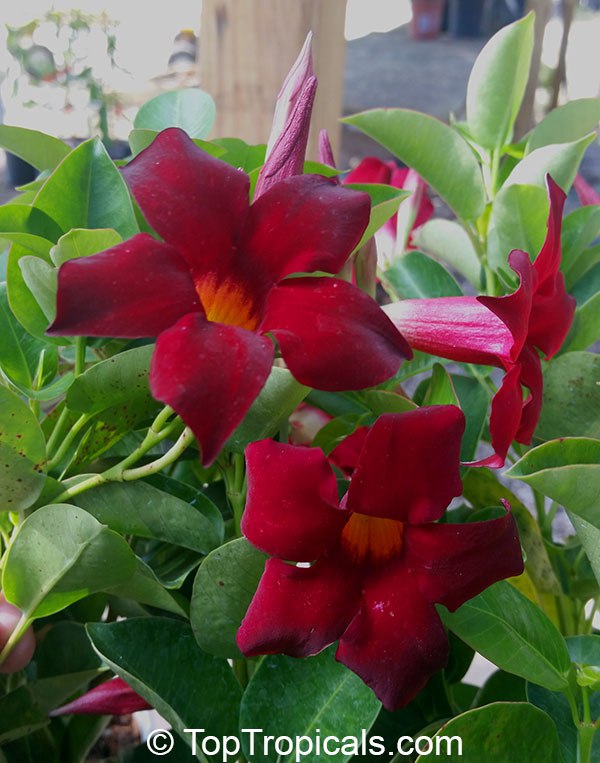
Mandevilla Sun Parasol Crimson
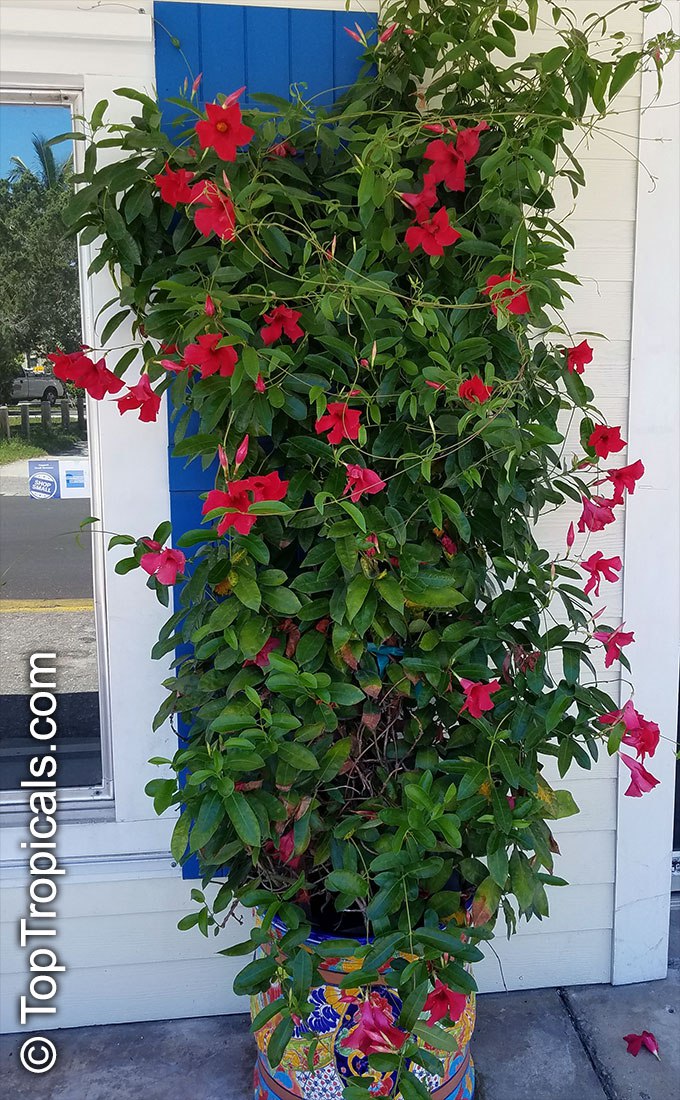
Mandevilla Sun Parasol Crimson on a trellis

Mandevilla amabilis Thai Rose
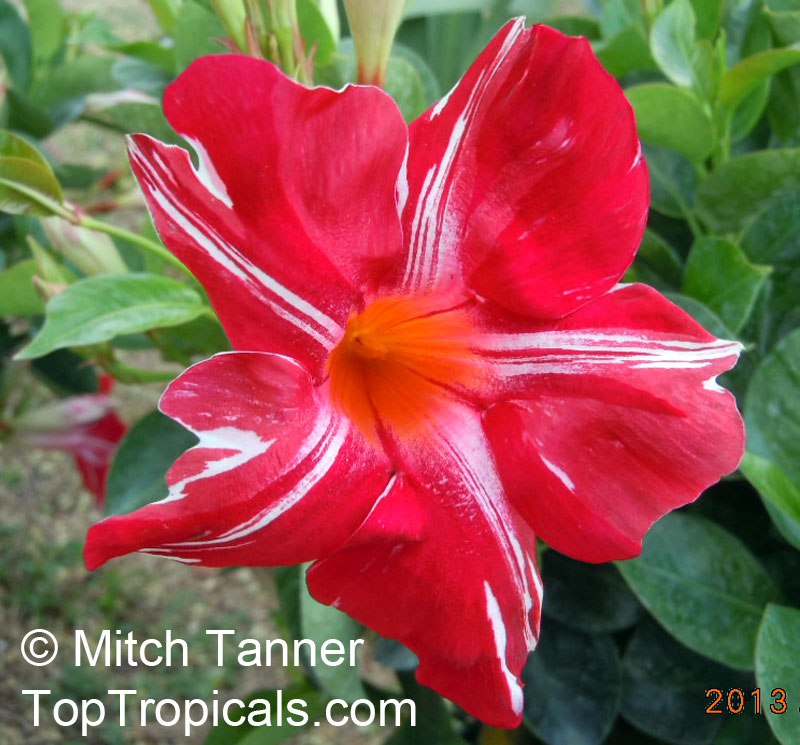
Mandevilla Stars and Stripes
- 🌺 Mandevilla is a tropical vine known for its vibrant, trumpet-shaped flowers that bloom throughout the warm months. This fast-growing climber thrives in warm climates and adds a stunning display of color to gardens and patios.
- 🌺 Difference Between Mandevilla and Dipladenia
- 🌺 Growing in the Ground
The names Mandevilla and Dipladenia are often used interchangeably, creating confusion. While they are closely related, there are key differences. Mandevilla is a vigorous woody vine with large, stiff leaves, ideal for trellises and fences. Dipladenia, on the other hand, has a more compact growth habit with smaller, smooth leaves. Dipladenia can be also trained on a trellis but also thrives in hanging baskets or as a compact specimen plant. As a bushier type of Mandevilla, its smaller, more compact varieties are excellent for mixed containers.
💋Soil. Mandevilla prefers well-draining soil enriched with organic matter. A mix of garden soil, compost, and sand ensures good drainage and fertility. Both Mandevilla and Dipladenia require acidic soil. If your native soil contains limestone, consider growing them in containers with a peat-based potting mix to maintain a lower pH.
- 💋Light. Plant in a location with full sun to partial shade; at least 6 hours of direct sunlight promotes the best blooms.
- 💋Feeding and Encouraging More Blooms: Feed Mandevilla with Sunshine Boosters Megaflor with every watering to encourage more blooms. Prune lightly after flowering to promote new growth and continuous flowering.
Water Mandevilla regularly, keeping the soil moist but not soggy. During hot months, water deeply a few times a week. Reduce watering in cooler seasons.
- 🌺 Most Interesting Varieties
Mandevilla flowers come in a wide range of colors, including shades of red, mauve, pink, white, and even yellow. For vibrant color and impact, consider these varieties:
💋Mandevilla ‘Alice du Pont’– A classic pink variety with large flowers and vigorous growth.
- 💋Mandevilla ‘Sun Parasol’ Series – Offers compact plants in deep red, pink, or white, great for containers or small spaces.
- 💋Mandevilla ‘Crimson Red’– Deep red blooms stand out against glossy green foliage.
- 💋Dipladenia ‘Stars and Stripes’ - features striking red-and-white striped blooms.
In Florida, Sun Parasol and Alice du Pont perform exceptionally well, thriving in the heat and humidity while providing season-long blooms.
- 🌺 Pests and Problems
Mandevilla is relatively pest-resistant but can attract aphids, spider mites, and whiteflies. To manage pests:
💋Spray with a neem oil solution weekly if pests are present.
- 💋Encourage beneficial insects like ladybugs to control aphids naturally.
- 💋Remove affected leaves and rinse plants with a strong stream of water.
- 💋Watch for fungal diseases in humid climates; ensure good air circulation and avoid overhead watering.
🌺 Growing Mandevilla in Pots and Winter Care
Mandevilla grows beautifully in containers, making it a great option for cooler climates where it can be brought indoors for winter.
- 💋Pot Growing Tips:
· Use a well-draining potting mix with added perlite for aeration.
- · Choose a pot at least 12-16 inches in diameter, with several drainage holes, for vigorous growth.
- · Water when the top inch of soil feels dry, avoiding waterlogged conditions.
💋Winter Care:
- · In regions with frost, move potted Mandevilla indoors to a bright, cool location (50-60°F).
- · Reduce watering and stop fertilizing during cooler season.
- · Prune lightly before bringing indoors to maintain shape and size.
- · Repotting: Repot every 2-3 years in early spring before active growth begins, refreshing the soil and upgrading to a slightly larger container if needed.
With the right care, Mandevilla provides stunning, long-lasting blooms and thrives in gardens or pots, making it a versatile and rewarding addition to any space.
📚 Learn more from previous post:
How to overwinter Mandevilla indoors
🛒 Shop flowering vines
#How_to #Container_Garden #Hedges_with_benefits
🔴 Join 👉 TopTropicals
How to Grow Jackfruit: Practical Guide
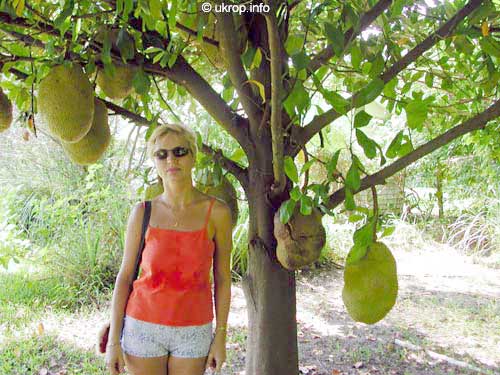
Jackfruit (Artocarpus heterophyllus) tree

Jackfruit (Artocarpus heterophyllus) fruit

Jackfruit (Artocarpus heterophyllus) fruit at the base of the tree
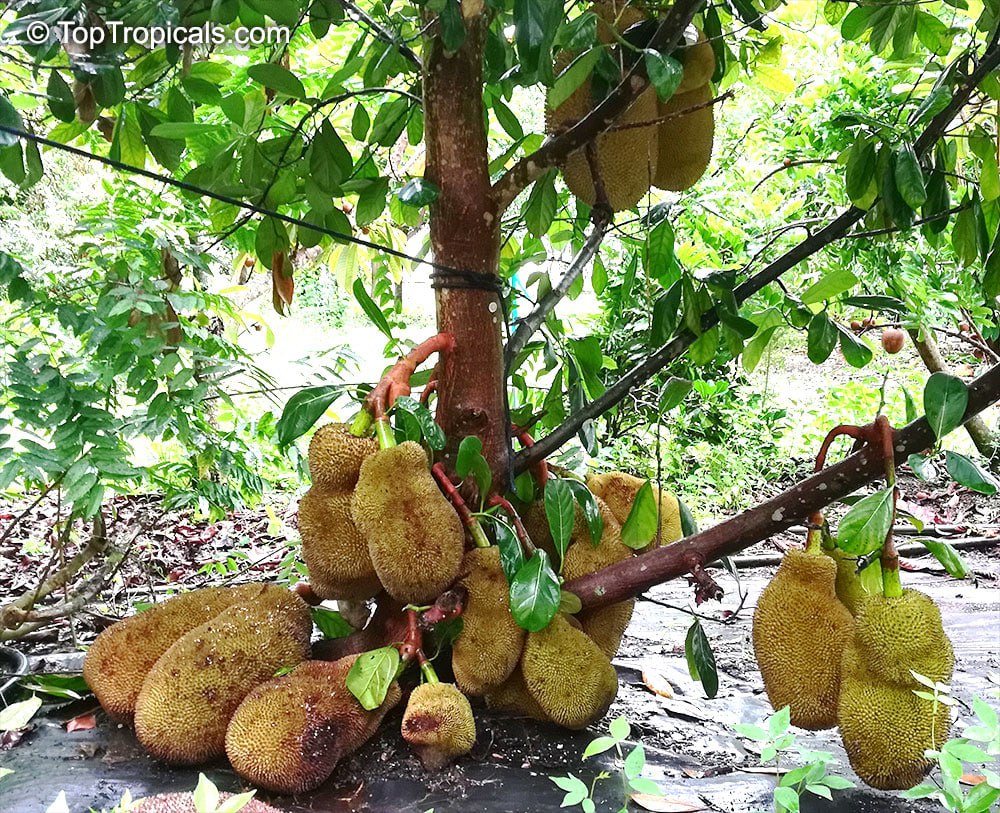
Jackfruit (Artocarpus heterophyllus) fruit at the base of the tree
- 🍈 Jackfruit (Artocarpus heterophyllus) is a tropical tree that produces the largest fruit in the world, weighing up to 80 pounds and reaching 36 inches in length. The trees thrive in frost-free, humid climates with plenty of sunlight. They require well-draining soil rich in organic matter and regular watering to flourish. Despite their reputation as ultra-tropical, mature Jackfruit trees can tolerate light frost for a few hours without significant damage. Additionally, they can be grown in containers in colder areas with proper care and pruning.
- 🍈 What Climate is Essential for Growing Jackfruit Trees?
- 🍈 How Often Do Trees Need Fertilizing, and What is the Best Type of Feed?
- 🍈 How Important is Pruning, and When is the Right Time to Prune?
- 🍈 Key Tips for Successful Jackfruit Production
Jackfruit trees require a tropical or subtropical climate, with temperatures ideally between 60-95°F. While young trees are frost-sensitive, mature trees can withstand light frost for short periods. However, cold winters can reduce fruit production. Frost-free temperatures are crucial for optimal growth and fruiting.
Jackfruit trees are heavy feeders. Fertilizing them regularly is key to their health and productivity. During the active growing season (spring to fall), apply a balanced dry fertilizer once a month. Liquid amino-acid-based fertilizers, such as Sunshine Boosters, can be used year-round with every watering. These fertilizers help maintain healthy growth and encourage abundant fruiting. Supplement with organic matter like compost, manure, or peat moss to enrich the soil.
Pruning is essential for maintaining a manageable tree size and promoting healthy fruit production. Jackfruit trees produce fruit at the base of the trunk, allowing them to be pruned annually to a height of 7-12 feet. This practice not only makes harvesting easier but also encourages more fruiting. Prune after the fruiting season or in late fall to remove excess growth and shape the tree. Regular pruning also improves air circulation and reduces the risk of disease.
- · Climate: Ensure frost-free temperatures and adequate humidity.
- · Soil: Use well-draining soil enriched with organic matter.
- · Watering: Maintain consistent soil moisture without waterlogging.
- · Pruning: Keep the tree under 7-10 feet for easier management and better yield.
- · Fertilizing: Apply balanced fertilizers and supplements regularly.
🍈 Jackfruit facts
- · The fruit consists of large, edible bulbs of yellow, sweet, banana-pineapple-flavored aromatic flesh.
- · Seedlings start fruiting within 3-4 years, with fruit ripening 4-6 months after flowering.
- · A mature tree can produce up to 200 pounds of fruit annually.
- · For colder regions, growing Jackfruit in containers is an option, provided the tree is regularly pruned and topped.
👍 Jackfruit trees grow fast and fruit abundantly with proper care, making them an exotic addition to tropical fruit collections.
📚 From previous posts:
The largest tree-borne fruit in the world
How to grow the biggest fruit on Earth
🛒 Plant your own Jackfruit
#Food_Forest #How_to
🔴 Join 👉 TopTropicals
Why my Lychee tree is not producing fruit and why I cant grow a Lychee tree from a seed?
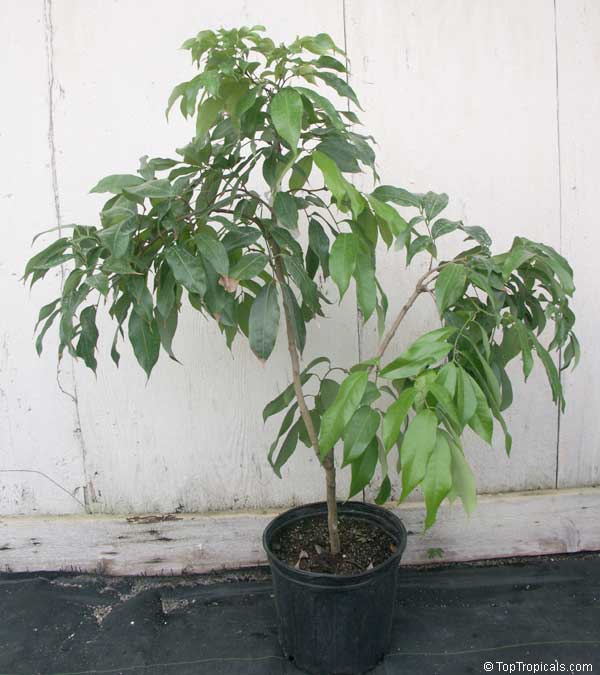
Lychee tree in a pot, Litchi chinensis
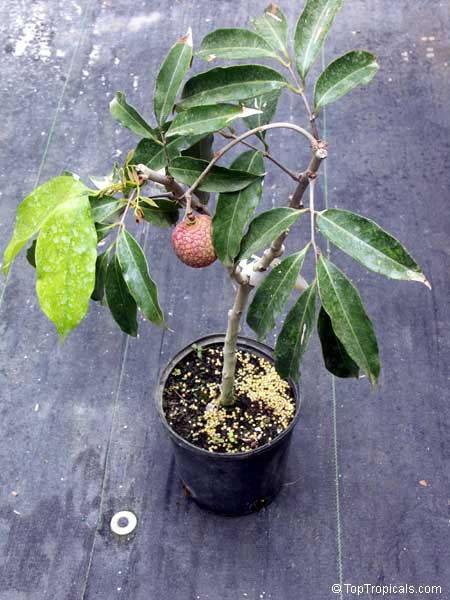
Lychee tree in a pot with fruit, Litchi chinensis
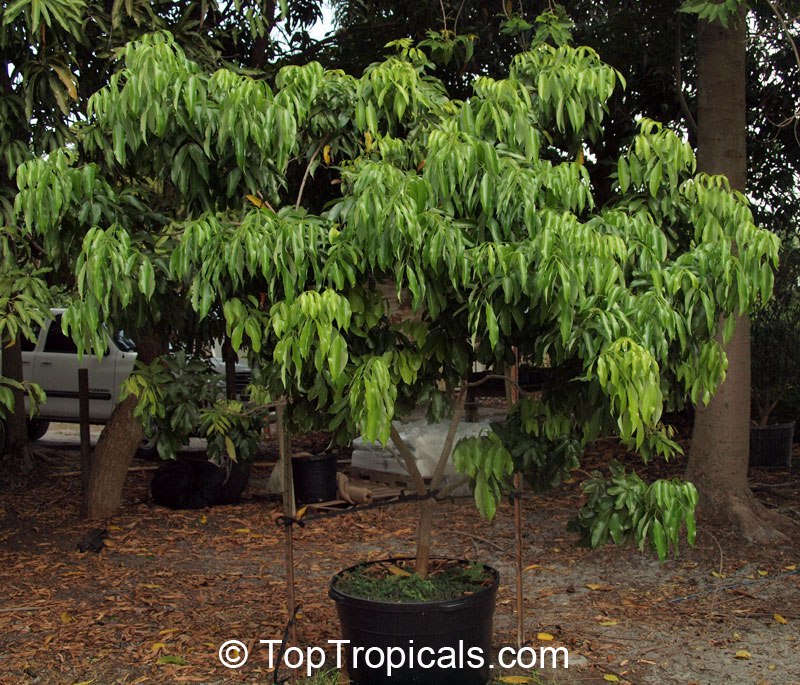
Lychee tree in a pot, Litchi chinensis
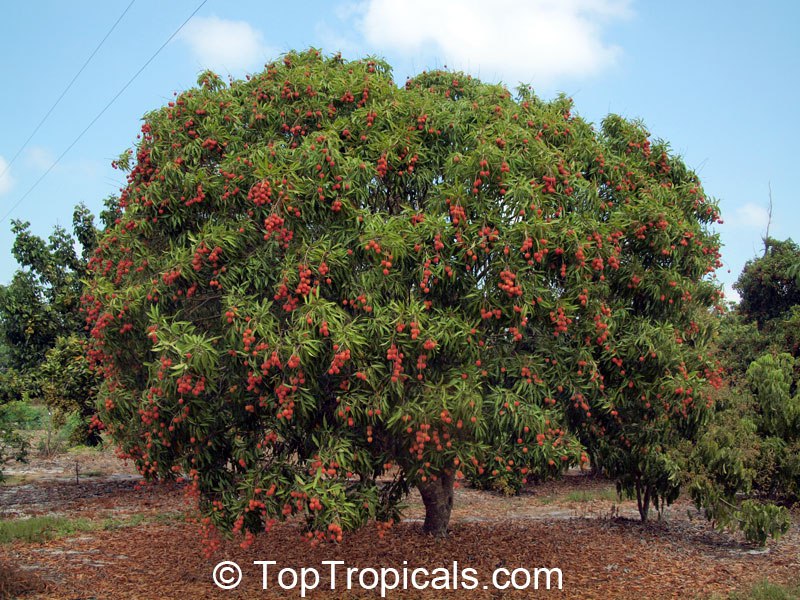
Lychee tree, Litchi chinensis
Practical advice on propagation and harvest- for the previous post 👆
- 🍑 Propagation and mycorrhiza
- 💋 Mycorrhiza is a symbiotic relationship between a fungus and plant roots. In a Lychee orchard, mycorrhiza plays a crucial role by enhancing the nutrient uptake of lychee trees, particularly phosphorus, leading to better growth and fruit production, especially in soils with low phosphorus availability.
- 💋Lychee trees are typically propagated by air layering, as they cannot be propagated effectively by seeds or grafting.
- 💋Lychee seedlings do not grow well because they require a special mycorrhizal environment that, in nature, is only provided under a mature mother tree. This dependency on mycorrhiza explains why lychee seedlings lack vigor and cannot serve as rootstocks for grafting.
- 💋If you have tried growing lychee from seed, you may have noticed that the seedling, after reaching a few inches in height, often stops growing or even shows signs of retarded growth. This is a clear indication of a lack of mycorrhiza.
- 💋The easiest way to have a healthy, productive Lychee tree, is to obtain a quality, air-layered tree from a reputable source.
🍑 Alternate Bearing in Lychee Trees
- 💋 Lychee trees often produce fruit every other year due to "alternate bearing", where the tree focuses on a heavy crop one year, leaving less energy for fruiting the next.
- 💋This cycle is influenced by weather, tree variety, and how flower buds develop alongside the current year's fruit. For example, "Mauritius" trees may bear fruit annually, while "Brewster" trees may produce a good crop only every 3-4 years.
By considering these factors and providing appropriate care, you can enjoy the beauty and bounty of a lychee tree in your garden.
📚 Learn more from previous posts:
The best varieties of Lychee
The best fruit in the world - grow your own Lychee tree
How to grow a Lychee tree
🛒 Shop Lychee trees
#Food_Forest #How_to
🔴 Join 👉 TopTropicals
How to grow a Lychee tree and have a reliable crop

Lychee fruit on a tree, Litchi chinensis
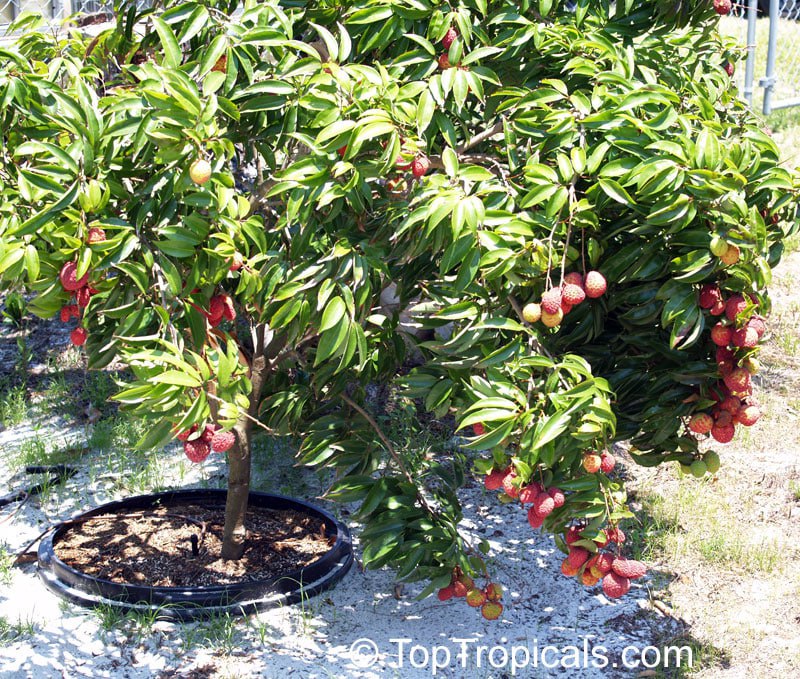
Lychee tree in a pot with fruit, Litchi chinensis
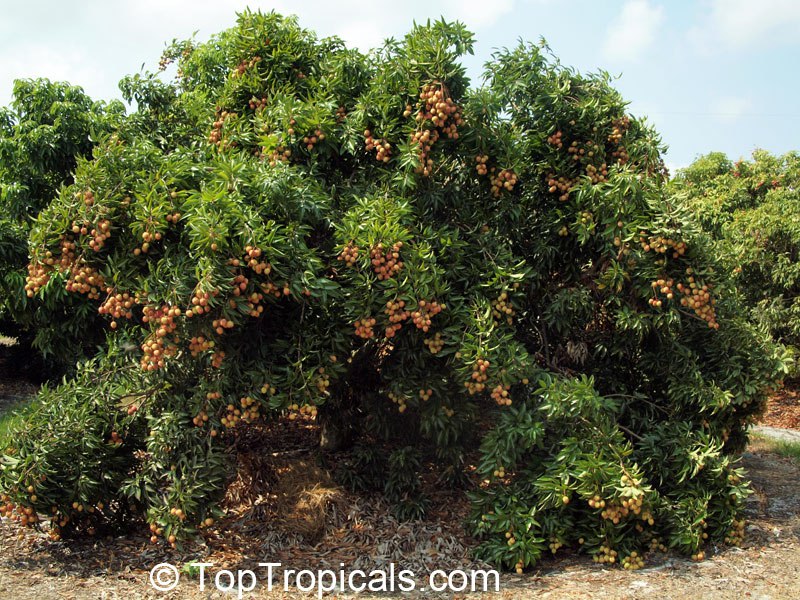
Lychee tree with fruit, Litchi chinensis
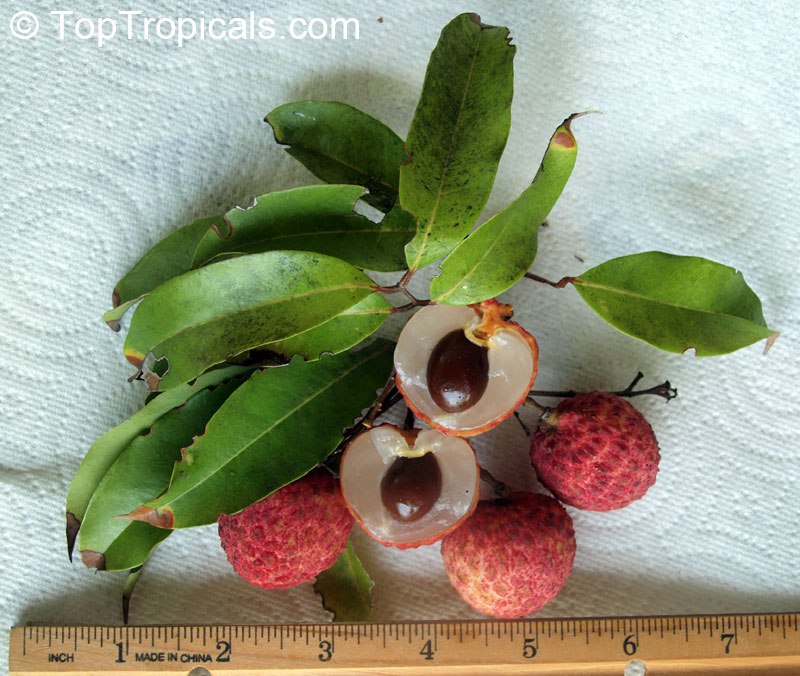
Lychee fruit, Litchi chinensis
- 🍑 Lychee (Litchi chinensis) is a tropical evergreen tree renowned for its delicious, aromatic fruit. Native to southern China, lychee trees can reach heights of up to 40 feet and are prized for their attractive foliage and bountiful fruit clusters.
- 🍑 Important factors to consider when planting a Lychee tree
- 💋Climate: Lychee trees thrive in tropical and subtropical climates with warm, humid summers and cool, dry winters. They require a period of winter chilling (100-200 hours between 32F and 45F) to induce flowering. Mature trees can tolerate temperatures as low as 25F, but young trees are susceptible to frost damage.
- 💋Sunlight: Plant lychee trees in full sun to ensure vigorous growth and optimal fruit production. They require at least six to eight hours of direct sunlight daily.
- 💋Soil: Well-drained, slightly acidic soils rich in organic matter are ideal. Avoid heavy clay soils or areas prone to waterlogging, as lychee trees are susceptible to root rot.
- 💋Spacing: Ensure adequate space for the tree's mature size by planting at least 20 feet away from other trees or structures.
- 🍑 When and how do you harvest lychee fruit?
- 💋Lychee trees typically begin to produce reliably after 3-5 years, with the fruit ripening in early summer.
- 💋Timing: Wait until the fruit's skin turns bright red or pink, indicating full ripeness. Lychees do not ripen off the tree, so it's essential to harvest at the right time.
- 💋Method: Use pruning shears to cut entire clusters, leaving a short stem attached to each fruit to prolong freshness. Handle the fruit gently to avoid bruising.
- 💋Post-Harvest: Consume fresh lychees within a few days or store them in the refrigerator to extend shelf life. The skin may darken when refrigerated, but the fruit's quality remains unaffected.
- 🍑 How to grow a Lychee tree?
- 💋Watering: Provide consistent moisture, especially during dry periods. However, avoid overwatering, as lychee trees are sensitive to waterlogged conditions. Mulching around the base helps retain moisture and regulate soil temperature.
- 💋Fertilization: Apply a balanced fertilizer during the growing season to support healthy growth and fruit development. Avoid excessive nitrogen, which can inhibit flowering. Sunshine Boosters C-Cibus - natural liquid fertilizer - is the best choice, and is safe to use with every watering year around.
- 💋Pruning: Minimal pruning is required. Remove dead or diseased branches and shape the tree to maintain its structure. Pruning after harvest can encourage new growth.
🍑 More practical advice on propagation and harvest in next post 👇
🛒 Shop Lychee trees
#Food_Forest #How_to
🔴 Join 👉 TopTropicals
How to protect tropical plants in Winter
- Winter Care Tips for Tropical Plants
- · Cut watering: Reduce watering to prevent root rot. Cold + wet = dead roots.
- · Water before frost: Thirsty plants are more vulnerable. Water them before a cold night to prevent damage.
- · Wind protection: Wind is more harmful than temperature drops. Plant near structures like houses or trees for shelter.
- · Prepare for long cold periods: If cold weather lasts for hours, use all available protection, including Christmas lights and propane heaters.
- · Don't use dry fertilizer in winter: Heavy fertilizing encourages tender growth, which is more susceptible to cold damage. Sunshine Boosters liquid fertilizers are safe to use year around as their intake is controlled by reduced watering.
- · Use fabric covers, not plastic: Plastic can cook plants in the sun, while fabric allows better ventilation.
- Prepare for Cold Nights:
- · Wrap plants: On cold nights, cover individual plants or trees with sheets or blankets to shield them from wind chill.
- · Use Christmas lights: A simple string of lights can add extra warmth, protecting your plants during frosty nights.
- · Use propane heaters: For added warmth in a larger area, place a propane heater near your plants. Make sure to follow safety guidelines and keep the heater at a safe distance from flammable materials. This can help maintain a few extra degrees of warmth, especially in more open garden spaces or temporary greenhouses. Always ensure proper ventilation to avoid harmful gas buildup.
- · Affordable winter greenhouse: For large plant collections, you don't need an expensive greenhouse. A mobile carport with plastic or fabric covering, costing around $200, can house up to 100 plants!
- Key Factors for Survival:
- · Cold duration: Tropical plants can survive brief cold spells but long durations, even above freezing, can be deadly.
- · Wind-chill: Wind chill can be harsher than the temperature itself.
- · Exposure: Southern-facing slopes hold heat longer, making them ideal for your plants.
- · Humidity: Proximity to lakes or oceans can create a milder micro-climate.
- · Gradual temperature Drops are safer. Plants adjust better to slow temperature changes than sudden cold blasts. Gradual cooling allows plants to prepare, reducing the risk of damage.
Strengthen Plant Hardiness:
· Health and maturity: Well-established, healthy plants are more cold-hardy.- · Boost plant immunity: Use products like SUNSHINE-Epi to improve cold resistance. Apply it before and during cold snaps to protect your plants.
- · Healthy plant is hardy. Make sure to fertilize your plants on regular basis - healthier and stronger plants are more cold hardy
#How_to
🔴 Join 👉 TopTropicals
New Year with New Plants: how to choose from 17 Tropical Paradise Resolutions
✍️ "A garden is never so good as it will be next year..." - Thomas Cooper.
⚡️ As we step into a fresh new year, it's the perfect time to think about what exciting, special, and life-changing plants we can add to our gardens. The days are getting longer, and spring is just around the corner, so now's the time to make a plan and prepare for the season ahead. Let's take small steps each year to create the garden of our dreams. This winter, consider these fun resolutions:
💋Hang a bird feeder and install a rain barrel- 💋Order some tropical plant seeds for an early start
- 💋Ask your grandparents about their favorite garden plants
- 💋Build a raised bed for succulents
- 💋Plant a fruit tree or two to have some crop this year
- 💋Start a compost pile
- 💋Switch to organic fertilizers and plant boosters
- 💋Fill empty spaces with flowering trees, shrubs, and vines
- 💋Add butterfly attractors to your garden
- 💋Provide water for bees and butterflies to help them thrive and pollinate your fruit trees
- 💋Get a bonsai starter to try bonsai art
- 💋Enjoy meals outside as often as you can
- 💋Teach a child how to plant a tree
- 💋Plant berry-bearing shrubs like Tropical Cherries to feed the birds
- 💋Rake up leaves for winter mulch
- 💋Add a few exotic plants to your indoor collection or container garden
- 💋Share plants as gifts all year long
- 🚩🚩🚩🚩 Happy gardening in 2025!
#How_to #Quotes
🔴 Join 👉 TopTropicals
How to eat a papaya?
😂 Cut it open, scoop out the seeds (they're not part of the fun), peel off the skin, and chop it up. Now enjoy the tropical sweetness – no passport required!
🎥 Or, if you are desperate and have no time for prep – do it like Cash in the video!
📚More from previous posts:
Why do we love Papaya?
How easy to grow is Papaya tree?
Top 10 fruit you'll ever need for your health benefits: #4 Papaya
Top 10 fast-fruiting trees: #6. Papaya
How to have fresh Papaya fruit year around
Top 3 most wanted Papaya varieties
The truth about Papaya
Papayas contain a secret enzyme
🛒 Shop Papaya trees
#Food_Forest #PeopleCats #How_to #Papaya
🔴 Join 👉 TopTropicals
Carefree Garden: How Easy Is It to Grow a Papaya Tree?
👆 For the previous post:
🎮 Practical Guide to Growing Papaya
❤️ Papaya is one of the fastest fruiting plants to grow.
❤️ How Easy Are Papaya Trees to Grow?
❤️ What Light Levels and Soil Types Are Ideal?
❤️ How Much Watering Is Required?
❤️ Growing Papayas in Containers
❤️ Health Benefits of Papaya
❤️ Papayas are a low-maintenance, high-reward addition to a Southern garden or greenhouse collection, whether in the ground or in a container. Their fast growth, year-round fruiting potential, and health benefits make them a must-have for gardeners and fruit enthusiasts alike.
Often starting production the same year from planting a seed, papayas are ideal for gardeners seeking quick rewards. Many dwarf varieties reach only 6-8 feet tall, yet produce large crops of full-sized fruit that are easy to harvest. Papaya trees are space-efficient, making it possible to plant multiple trees in even small gardens. Plant 2-3 different cultivars to enjoy year-round harvests of healthy, delicious fruit.
Papaya trees are exceptionally easy to grow. Technically a large herbaceous plant rather than a true tree, they are resilient and adaptable. They can tolerate light freezes and even hurricane winds without significant damage. Additionally, many varieties are self-fertile, but planting multiple trees encourages better pollination and higher yields.
Papayas thrive in full sunlight, so choose a sunny spot in your garden or balcony. They prefer well-draining, fertile soil enriched with organic matter. Add compost or manure to improve soil quality and ensure healthy growth. Avoid waterlogged areas as papayas are sensitive to standing water.
Papayas need consistent watering to thrive, especially during the growing and fruiting seasons. Water deeply once or twice a week, depending on your climate, ensuring the soil remains moist but not waterlogged. Mulching around the base helps retain moisture and regulate soil temperature.
Papayas can be successfully grown in large containers, making them ideal for gardeners in cooler regions or those with limited space. Choose a container at least 15 gallons in size with good drainage. Use a rich, well-draining potting mix, and place the container in a sunny location. Select dwarf varieties to keep the plant manageable and productive.
Papaya is considered a superfood due to its high nutritional value. Rich in the enzyme papain, it aids digestion and promotes gut health. Papaya is also an excellent source of vitamins A, C, and E, as well as antioxidants that boost immunity and overall wellness. Additionally, papaya leaves can be used as wraps for cooking meats, naturally tenderizing them.
📚More from previous posts:
Top 10 fruit you'll ever need for your health benefits: #4 Papaya
Top 10 fast-fruiting trees: #6. Papaya
How to have fresh Papaya fruit year around
Top 3 most wanted Papaya varieties
The truth about Papaya
Papayas contain a secret enzyme
🛒 Shop Papaya trees
#Food_Forest #How_to #Papaya
🔴 Join 👉 TopTropicals
How to grow your own vanilla orchid at home

Vanilla Bean Orchid (Vanilla planifolia)
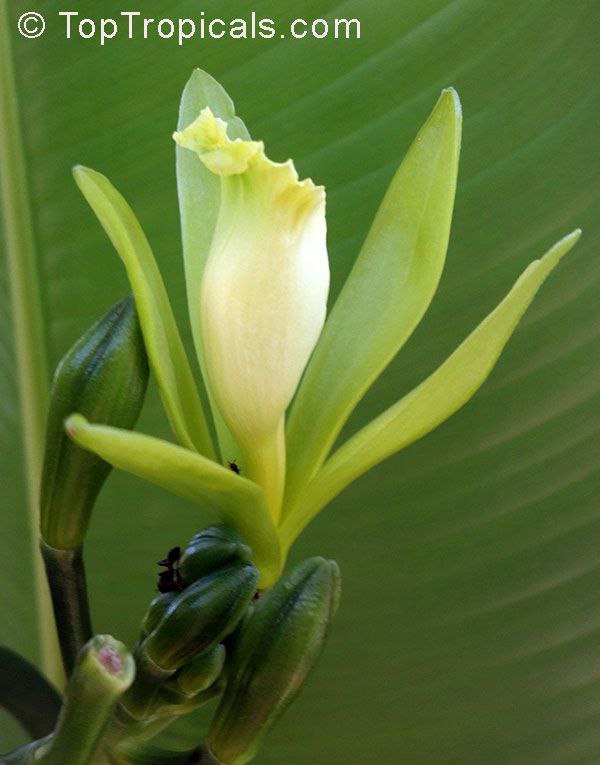
Vanilla Bean Orchid (Vanilla planifolia), flower
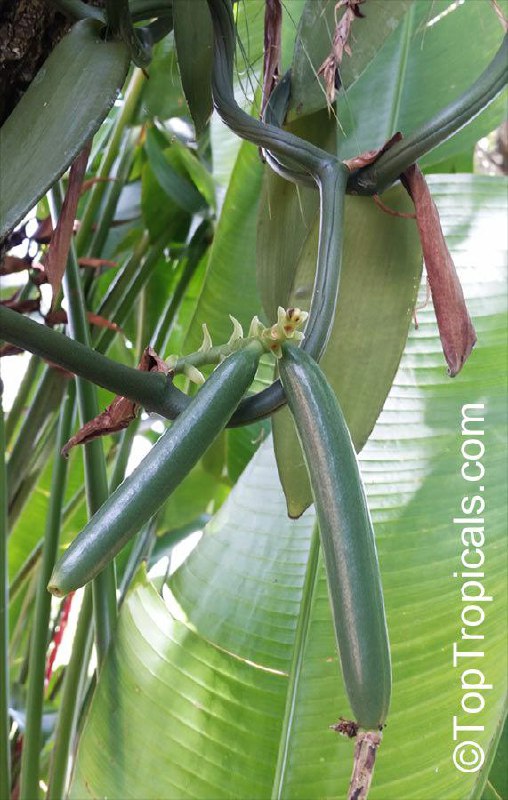
Vanilla Bean Orchid (Vanilla planifolia), seed pods beans

Vanilla Bean Orchid (Vanilla planifolia)
- 🍨 The Vanilla Bean Orchid (Vanilla planifolia) is a tropical climbing beauty and the source of the world’s favorite spice - vanilla. This luxurious plant adds elegance to any space, indoors or out.
- 🍨 A piece of history: Once revered by the Aztecs for flavoring the decadent cacao drink Xoco-latl, vanilla remains a symbol of comfort, luxury, and flavor.
- 🍨 Why it's special: Vanilla pods are scentless at first and develop their rich aroma after careful curing - a reason it’s the second most expensive spice after saffron.
- 🍨 How to grow Vanilla Orchid:
- · Support: Use a trellis, log, or burlap-covered board for climbing.
- · Light: Bright, indirect light works best.
- · Environment: Keep it warm and humid, like its natural tropical habitat.
- · For pots: Add a mini-trellis or small log to mimic its natural climbing needs.
- 🍨 Why you'll love it:
- 🍨 Ready to start your vanilla journey? Add a Vanilla Bean Orchiв to your cart and bring this fragrant, elegant treasure home today!
Growing your own vanilla means adding a slice of the tropics to your home, with the chance to harvest your own vanilla beans for homemade extracts. It's beautiful, exotic, and endlessly rewarding.
📚 Learn more from previous post:
The Secret of how to Make Vanilla Orchid bloom
🛒 Shop Vanilla Bean Orchids
#Shade_Garden #How_to
🔴 Join 👉 TopTropicals
How to care for your mango tree in winter
If you want to enjoy mangoes like ours (in the video) next summer, protecting your tree in winter is a must! Give it the care it needs now, and you'll reap sweet rewards when the warm weather returns.
Keep it cozy and protected: Mango trees love warmth, so when winter comes, they need extra care to stay happy.
Temperature: Mango trees are sensitive to cold. If temperatures drop below 35F, cover the tree with frost cloth or burlap to protect it. For potted mango trees, move them indoors or to a greenhouse.
Watering: Reduce watering during winter. Mango trees don’t like soggy roots in cold weather. Let the soil dry slightly between waterings.
Mulching: Add a thick layer of mulch around the base of the tree to insulate the roots and retain warmth. Keep the mulch a few inches away from the trunk.
No pruning: Avoid heavy pruning in winter, as it can stress the tree. Besides, pruning promotes young tender growth that may get cold damaged. Save major trimming for spring.
Feeding: Stop dry fertilizer in winter. The tree slows its growth, so too much dry fertilizer can do more harm than good. You can continue using Sunshine Boosters Mango Tango year-round because it is water-soluble and natural, and the amount of food needed will adjust with reduced watering.
🛒 Shop Mango Trees
#Food_Forest #How_to #Mango
🔴 Join 👉 TopTropicals

